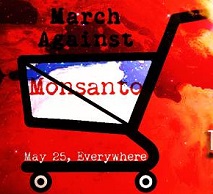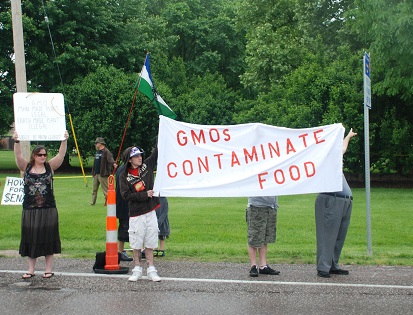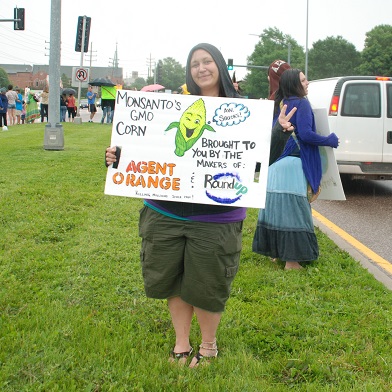 Protesters – an estimated 535 in all – planted seeds of resistance at Monsanto’s corporate headquarters in the greater St. Louis area on May 25.
Protesters – an estimated 535 in all – planted seeds of resistance at Monsanto’s corporate headquarters in the greater St. Louis area on May 25.
The event was part of the world-wide March Against Monsanto. Eschewing top-down, vertical means of change, concerned activists across the political and socioeconomic spectrum opted for grassroots organizing to mount opposition to Monsanto and the genetically modified organisms (GMOs) the company aggressively pushes.
Author and activist Merlyn Seeley, of Houston, Mo., organized the St. Louis area event. Among myriad reasons to inveigh against the corporation, Seeley considered it especially important in light of the recent passage of the Monsanto Protection Act — a rider that “does protect them,” Seeley said, noting also that “they had to sneak it in,” because Monsanto knows “there’s no other way they could get it passed.”
Opposed by the Organic Consumers Association and the Alliance for Natural Health, the law was dubbed the “Monsanto Protection Act” by Food Democracy Now!, and the aforementioned organizations — along with a plethora of people concerned about potential adverse effects of genetically engineered (GE) foods — started using the nickname, The Center for Media and Democracy reported.
Seeley felt further compelled to organize the March Against Monsanto at corporate headquarters because of the company’s monopolistic control over seeds and the food supply.
“Basically, they’re taking over the entire food system,” Seeley said. “They know what they’re doing.”
He decried Monsanto’s monopolistic control over soy and corn in the United States, especially since those are the two main sources used to feed the major livestock raised in this country. He considers Monsanto’s destruction of the heirloom varieties of corn and other crops as one of the gravest threats faced by farmers and growers today, because you can never get those back, he said.
Not one to exaggerate, Seeley nevertheless didn’t hesitate to sum up Monsanto’s profit-over-people GE hegemony.
“That’s evil,” he said. And how is evil overcome? “It’s overcome by the people not giving up — and standing up.
“When people stand together that’s a force that cannot be reckoned with. … The power of the people is stronger now than it ever has been. People are tired of it. They’re standing up.”
 More than 500 did stand up May 25 outside Monsanto headquarters, despite rain showers early on. Activists carried an array of handmade signs. One held an anti-Monsanto sign featuring a picture of re-knowned Indian environmental researcher Vandana Shiva, who has called Monsanto’s corporatization scheme “the ultimate seeds of suicide,” in large part because of the epidemic of farmer suicides in India, in which a quarter million peasants have taken their own lives as a result of getting trapped in a cycle of debt when forced to buy Monsanto’s costly cotton seeds and chemicals that dominate the market. Shiva also likens the process to “seeds of deception — the deception that Monsanto is the creator of seeds and life; the deception that while Monsanto sues farmers and traps them in debt, it pretends to be working for farmers’ welfare, and the deception that GMOs feed the world. GMOs are failing to control pests and weeds, and have instead led to the emergence of superpests and superweeds.”
More than 500 did stand up May 25 outside Monsanto headquarters, despite rain showers early on. Activists carried an array of handmade signs. One held an anti-Monsanto sign featuring a picture of re-knowned Indian environmental researcher Vandana Shiva, who has called Monsanto’s corporatization scheme “the ultimate seeds of suicide,” in large part because of the epidemic of farmer suicides in India, in which a quarter million peasants have taken their own lives as a result of getting trapped in a cycle of debt when forced to buy Monsanto’s costly cotton seeds and chemicals that dominate the market. Shiva also likens the process to “seeds of deception — the deception that Monsanto is the creator of seeds and life; the deception that while Monsanto sues farmers and traps them in debt, it pretends to be working for farmers’ welfare, and the deception that GMOs feed the world. GMOs are failing to control pests and weeds, and have instead led to the emergence of superpests and superweeds.”
“Monsanto’s concentrated control over the seed sector in India as well as across the world is very worrying,” she wrote. “This is what connects farmers’ suicides in India to Monsanto vs Percy Schmeiser in Canada, to Monsanto vs Bowman in the US, and to farmers in Brazil suing Monsanto for $2.2 billion for unfair collection of royalty.”
Seeley said the Bowman lawsuit was wrong, but he noted it was not that surprising.
“Monsanto is the biggest bully in America,” he said. “It’s going to change.”
Shelli Jones, 33, traveled from Joplin, Mo., to participate in the protest taking place at Monsanto’s front door. She loathes the fact that Monsanto — who has the dubious distinction of being the creator of dioxin-containing Agent Orange defoliant sprayed throughout the South Vietnamese countryside during the Vietnam War, infecting local populations and American soldiers — has made it increasingly difficult for working people to live and eat healthily. She criticizes Monsanto and the system of corporate capitalism that imperils average citizens who can’t always afford to eat organic and do not have time to grow all of their own food to feed their family GMO-free meals.
“I’m on food stamps, and I can’t eat good food? Bullshit!” she said.
Jones gets her son off to school in the morning, goes to work, runs during her lunch hour, picks her son up after school, goes to work in the evening and tries to garden when she gets home. Despite the busy schedule, she felt it imperative to protest against the unaccountable private control Monsanto wields, and she hoped to help inform the public about what is going on.
Jones showed up the night before the event for a sign-making party, GMO-free potluck dinner, and campout at Carondelet Garden Urban Farm located in South St. Louis.
“Sleeping in a tent in a random garden?” she asked rhetorically. “Sure, why not?”
Mark Brown, a long-time activist and organizer, invited those who planned to demonstrate on May 25 over to the urban garden the night before. Walking barefoot throughout the garden the day prior, then during the march from the gathering spot at Stacy Park to Monsanto headquarters and remaining sans shoes throughout the demonstration, Brown also nearly lost his voice standing outside the entrance to the company’s property, rallying protesters and raising spirits as the rain came down.
Brown said the people are “not going to tolerate” having a handful of individuals making decisions about who in the world gets to eat and who doesn’t, and who gets access to safe seeds and who doesn’t.
“Seeds are our birthright,” he said. “They were given to us by our ancestors. No one has the right to control seeds.”
Echoing Brown’s sentiments, Lisa Wolfrey, another concerned citizen who showed up for the sign-making rally at Carondelet Garden with her daughter, went to Stacy Park the next day, marched the mile and a half to Monsanto’s property and protested with a sign reading “Save Seeds” painted in big red letters across a brown-colored, earthy woven fabric.
Wolfrey despises what, like author Vandana Shiva, she considers “seeds of deception,” and she believes something is fundamentally wrong when, “You can’t go in the store without being poisoned.”
 Because Monsanto “totally monopolizes the seed market” she knows people will soon “no longer have healthy, non-contaminated seeds” available at an affordable price. Wolfrey implicates Monsanto in what world systems analyst Andre Gunder Frank called “The Underdevelopment of Development.”
Because Monsanto “totally monopolizes the seed market” she knows people will soon “no longer have healthy, non-contaminated seeds” available at an affordable price. Wolfrey implicates Monsanto in what world systems analyst Andre Gunder Frank called “The Underdevelopment of Development.”
“There’s enough food right now to feed the world,” she said. But unchecked corporate control over the food system — contrary to popular belief — actually contributes to world hunger, she explained. Moreover, those who do eat, are usually not eating well. She and her daughter both suffered from health problems, which are only now starting to subside after she eliminated all GMO-containing foods from their diet.
She says she is “tired of being sick,” and regrets that more people do not yet realize GE food consumption often “kills natural organisms in [the] gut,” which is what motivated her activism against Monsanto.
Similarly, Seeley remarked how eating genetically modified foods can turn one’s organs into a “pesticide factory.” In one major scientific study examining the effects of GM maize consumption, researchers concluded that their “data strongly suggests that these GM maize varieties induce a state of hepatorenal toxicity. This can be due to the new pesticides (herbicide or insecticide) present specifically in each type of GM maize, although unintended metabolic effects due to the mutagenic properties of the GM transformation process cannot be excluded.”
The authors also noted a “clear negative impact on the function” of major detoxifying organs like the kidney and liver “in rats consuming GM maize varieties for just 90 days.” They added that, “These substances have never before been an integral part of the human or animal diet and therefore their health consequences for those who consume them, especially over long time periods are currently unknown.”
The unknown, potentially adverse effects of GM food consumption is a cause for concern among much of the American public and people around the world. Wolfrey acknowledges a lot of people have woken up to this, and she hopes the May 25 event serves as another eye-opener.
Activists on site at the protest passed out fliers with facts about Monsanto and reasons to support labeling of GMOs, which Monsanto lobbies against.
Wolfrey recommends people check out the documentary “Food, Inc.” to learn more about the state of the food industry.
Despite the dire situation at present, large-scale protests, like what took place May 25, give her hope.
“I can’t help but be hopeful,” she said. “I wouldn’t be here if I didn’t have some hope.”
More than 500 others who stood in the rain in front of Monsanto headquarters May 25 expressed similar beliefs. The number of solidarity car-horn honks and approving waves from motorists suggest even more people feel the same.
James Anderson is a Ph.D. student in Mass Communications and Media Arts at Southern Illinois University Carbondale. His interests include social movements, political economy, alternative media, alternative economic paradigms, world systems analysis, critical pedagogy, prefigurative praxis, direct action and satire. His words are his weapon, and, like so many others, he believes another world is possible.
